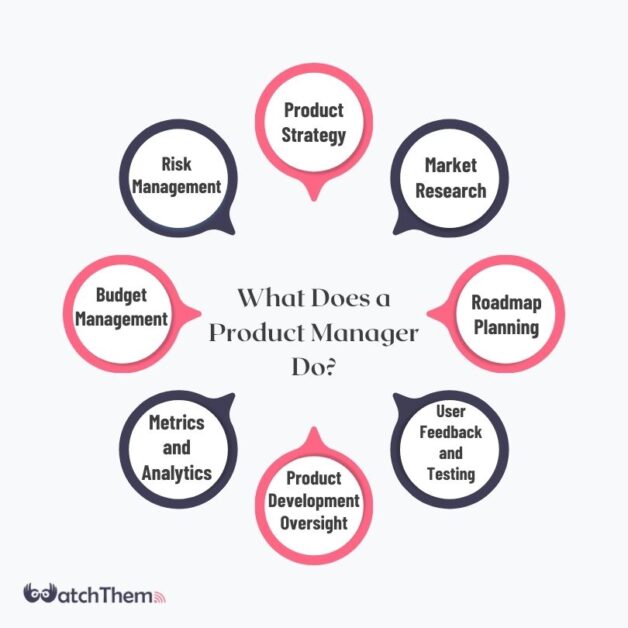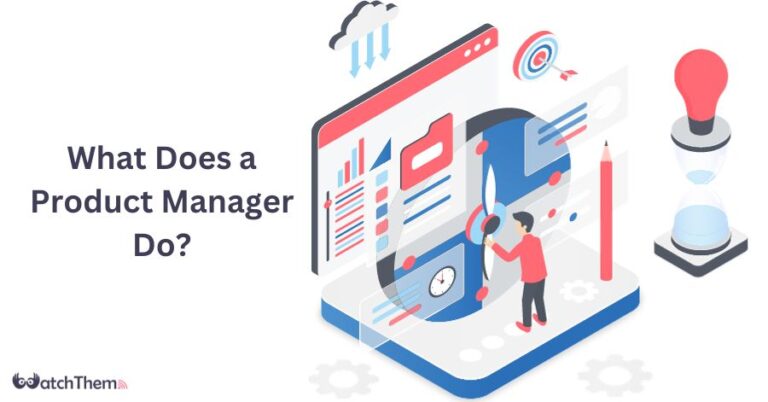Page Contents
Embarking on a career journey marks a crucial turning point—one of those defining moments that shape the course of our lives. As you navigate the path towards your dream job, you may come across the title of a product manager, and wonder: What does a product manager do?
In fact, the product manager job is one of the most well-paid and promising career paths available today. As a relatively new title, it covers a broad field, from defining the product roadmap to conducting customer analysis. However, this title has always existed in different forms and continues to be a necessity in every business.
In this guide, we’ll elaborate more on the product manager job description, the necessary skill set required for this role, and explain how you can become a successful PM. So, let’s begin!
What Is Product Management
Do you want to learn how to become a product manager? Well, you should start with the basics. Product management is a strategic function within organizations that guides teams through the entire lifecycle of a product, from development to execution.
Originally part of marketing or engineering teams, product management has evolved into its own team within tech companies, often with one manager per product. The department oversees the product lifecycle, ensuring alignment with user needs and business goals. It’s a multidisciplinary field that demands adaptability and involves product research, planning, development, launch, and ongoing management.
Product management originated in the 1930s, gained traction in the 1980s with agile processes, and was further streamlined by the Agile Manifesto in 2001. Now that you know what product management is, it’s time to answer ‘What does a product manager do?’ and see how you can become one.
What Does a Product Manager Do
A product manager (PM) plays a pivotal role in the development and success of a product. The primary responsibility of a product manager is to bridge the gap between the business strategy, user needs, and the technical development team.
PMs are involved in every phase of the product lifecycle, from ideation to launch and ongoing improvement. They start by conducting market research and gathering user feedback to understand customer needs, pain points, and market trends.
Once armed with this information, a product manager works closely with cross-functional teams, including designers, engineers, and marketers, to define the product roadmap, strategy, and vision. They prioritize features and functionalities and keep a close eye on product metrics.
During the development phase, product managers act as the voice of the customer, making decisions that balance user needs with business objectives. They collaborate with the engineering team to address challenges, provide feedback, and iterate on the product.
PMs are also responsible for setting and tracking key performance indicators (KPIs) to measure the success of the product. Post-launch, they continue to monitor performance, gather user feedback, and iterate on the product to ensure its continuous improvement.
In addition to these responsibilities, product managers are often involved in stakeholder management, budgeting, and risk assessment. They must be adaptable, strategic thinkers who can navigate the complexities of both business and technology to deliver successful products that meet customer needs and drive business growth.
Overall, the role of a product manager is dynamic, requiring a combination of analytical, communication, and leadership skills to guide a product from concept to market success. To better understand whether this role is a good fit for you, you need to know about the product manager job description.
In the following, we’ll go over some of the key responsibilities of product managers. So, keep reading!
Product Manager Job Description
As we mentioned earlier, the role of a product manager is multifaceted and can vary depending on the organization, industry, and the specific product or service being managed. Therefore, there is no definite answer to ‘What does a product manager do day to day?’.
However, there are some key responsibilities that are commonly associated with the role of a product manager:


- Product Strategy: Develop and communicate the product vision and strategy. This involves understanding market trends, customer needs, and competitive landscapes.
- Market Research: PMs conduct market research to identify opportunities, assess competition, and gather insights that can inform product decisions.
- Roadmap Planning: This responsibility is also a part of the product manager job description. They should create and maintain a product roadmap that outlines the short-term and long-term goals for the product, considering business objectives and user needs.
- User Feedback and Testing: Gather and analyze user feedback to iterate on existing features and guide the development of new ones. Conduct usability testing to ensure the product meets user needs.
- Product Development Oversight: Oversee the product development process, ensuring that the team is on track to deliver high-quality products on time and within budget.
- Metrics and Analytics: Define key performance indicators (KPIs) and use analytics to measure the success of the product. Analyze data to identify areas for improvement and make data-driven decisions.
- Budget Management: Manage the budget for product development, ensuring that resources are allocated effectively to meet business goals.
- Risk Management: Identify risks associated with product development and implementation.
A successful product manager is able to navigate the intersection of business, technology, and user experience to deliver products that meet both customer needs and business objectives.
How to Become a Product Manager
If you’re determined to become a product manager and flourish your potential, we’ve got you covered! Becoming a successful product manager requires a combination of education, skills development, and practical experience.
Here’s a step-by-step guide on how to become a product manager:
#1 Understand the Role
Begin by gaining a comprehensive understanding of the responsibilities and expectations of a product manager. That’s why in this article, we tried to answer any questions you might have faced, including ‘What does a product manager do?’, ‘What is the PM job description’, and how to become one.
#2 Educational Background
While there is no specific educational path, having a bachelor’s degree in business, marketing, engineering, or a related field can be beneficial. Consider pursuing a master’s degree or relevant certifications to enhance your knowledge and credibility.
In addition to that, you can partake in product management courses to increase your knowledge and learn the necessary skills.
#3 Build a Strong Foundation
Develop a solid foundation in business and technology. Familiarize yourself with project management methodologies, product lifecycle, and market trends. This knowledge will be crucial in making informed decisions as a product manager.
#4 Gain Relevant Experience
Seek internships, entry-level positions, or projects that expose you to product management tasks. This hands-on experience will provide valuable insights into the day-to-day responsibilities of a product manager.
#5 Develop Technical Skills
While you don’t need to be a developer, having a basic understanding of technology and the development process is crucial. Familiarize yourself with product management tools, data analysis, and any relevant software used in your industry.
#6 Build a Portfolio
Showcase your skills and accomplishments through a portfolio. Include projects you’ve worked on, detailing your role, challenges faced, and the impact on the product. This tangible evidence will set you apart during job interviews.
#7 Apply for Product Management Roles
Start applying for entry-level or associate product manager positions. Tailor your resume and cover letter to highlight your relevant skills and experiences. Be prepared to discuss your portfolio and demonstrate your understanding of the product management process.
Following these steps will allow you to increase your chances of not only securing a product manager role but excelling in it.
Product Manager Salary in 2024
Like any other role in the business world, the salary for product managers can vary based on factors such as experience, industry, and location. The average annual salary for product managers stands at an impressive $156,577 in the US.
product manager salaries are influenced by the high demand for professionals in this role, which has consistently increased in recent years. The active job listings on platforms like Glassdoor reflect a strong job market, with salaries ranging from $121,000 to $205,000, and some exceptional offers going up to $296,000.
It’s only natural that as individuals gain more years of experience in Product Management, their earning potential is likely to increase, offering a pathway to further financial growth and career advancement.
FAQs
In this guide, we tried to answer those curious minds asking ‘What does a product manager do?’. We also elaborated on the product manager job description, salary, and responsibilities. Now, it’s time to answer some related questions.
Q1. What Does a Product Marketing Manager Do?
While a product manager focuses on the development and lifecycle of a product, a Product Marketing Manager is responsible for promoting and positioning that product in the market.
Product Marketing Managers work on creating marketing strategies, defining target audiences, developing messaging, and collaborating with various teams to ensure the successful launch and ongoing promotion of the product.
Q2. Is Product Manager a High Role?
Yes, the role of a product manager is considered a high-level and influential position within an organization. product managers play a crucial role in driving the success of a product, aligning it with business goals, and meeting customer needs. The strategic nature of the role and its impact on business outcomes contribute to its status as a high-level position.
Q3. What Does a Technical Product Manager Do?
A Technical product manager is a specialized role within product management that requires a deep understanding of both the technical aspects of a product and the strategic business goals.
Unlike a general product manager, a Technical product manager often has a strong technical background, such as in software development or engineering. Their responsibilities include translating technical requirements into product features, collaborating with development teams, and ensuring that the technical aspects of a product align with business objectives.
Conclusion
The role of a product manager is dynamic and essential, and it requires a diverse skill set to bridge business strategy, user needs, and technical execution.
By following our step-by-step guide, individuals wanting to know how to become a product manager can learn the necessary tips for success in this challenging yet rewarding field. Good luck!

